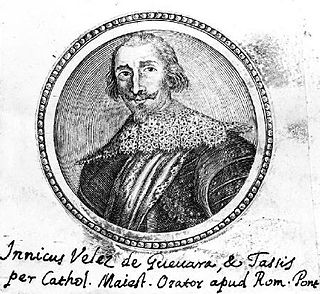
Albert III was a Duke of Saxony. He was nicknamed Albert the Bold or Albert the Courageous and founded the Albertine line of the House of Wettin.

Frederick III was Holy Roman Emperor from 1452 until his death in 1493. He was the penultimate emperor to be crowned by the pope, and the last to be crowned in Rome. He was the first emperor from the House of Habsburg, which was to retain the title until it disappeared centuries later.

Maximilian II was Holy Roman Emperor from 1564 until his death in 1576. A member of the Austrian House of Habsburg, he was crowned King of Bohemia in Prague on 14 May 1562 and elected King of Germany on 24 November 1562. On 8 September 1563, he was crowned King of Hungary and Croatia in the Hungarian capital Pressburg. On 25 July 1564, he succeeded his father Ferdinand I as Holy Roman Emperor.

Matthias was Holy Roman Emperor from 1612 to 1619, Archduke of Austria from 1608 to 1619, King of Hungary and Croatia from 1608 to 1618 and King of Bohemia from 1611 to 1617. His personal motto was Concordia lumine maior.

Ferdinand II was Holy Roman Emperor, King of Bohemia, Hungary, and Croatia from 1619 until his death in 1637. He was the son of Archduke Charles II of Inner Austria and Maria of Bavaria, who were devout Catholics. In 1590, when Ferdinand was 11 years old, they sent him to study at the Jesuits' college in Ingolstadt because they wanted to isolate him from the Lutheran nobles. A few months later, his father died, and he inherited Inner Austria–Styria, Carinthia, Carniola and smaller provinces. His cousin, Rudolf II, Holy Roman Emperor, who was the head of the Habsburg family, appointed regents to administer these lands.

Ladislaus V, more commonly known as Ladislausthe Posthumous, was Duke of Austria and King of Hungary, Croatia and Bohemia. He was the posthumous son of Albert of Habsburg with Elizabeth of Luxembourg. Albert had bequeathed all his realms to his future son on his deathbed, but only the estates of Austria accepted his last will. Fearing an Ottoman invasion, the majority of the Hungarian lords and prelates offered the crown to Vladislaus III of Poland. The Hussite noblemen and towns of Bohemia did not acknowledge the hereditary right of Albert's descendants to the throne, but also did not elect a new king.

George of Kunštát and Poděbrady, also known as Poděbrad or Podiebrad, was the sixteenth King of Bohemia, who ruled in 1458–1471. He was a leader of the Hussites, but moderate and tolerant toward the Catholic faith. His rule was marked by great efforts to preserve peace and tolerance between the Hussites and Catholics in the religiously divided Crown of Bohemia – hence his contemporary nicknames: "King of two peoples" and "Friend of peace".

Matthias Corvinus was King of Hungary and Croatia from 1458 to 1490, as Matthias I. After conducting several military campaigns, he was elected King of Bohemia in 1469 and adopted the title Duke of Austria in 1487. He was the son of John Hunyadi, Regent of Hungary, who died in 1456. In 1457, Matthias was imprisoned along with his older brother, Ladislaus Hunyadi, on the orders of King Ladislaus the Posthumous. Ladislaus Hunyadi was executed, causing a rebellion that forced King Ladislaus to flee Hungary. After the King died unexpectedly, Matthias's uncle Michael Szilágyi persuaded the Estates to unanimously proclaim the 14-year-old Matthias as king on 24 January 1458. He began his rule under his uncle's guardianship, but he took effective control of government within two weeks.

John Hunyadi was a leading Hungarian military and political figure during the 15th century, who served as regent of the Kingdom of Hungary from 1446 to 1453, under the minor Ladislaus V.

The Habsburg monarchy, also known as Habsburg Empire, or Habsburg Realm, was the collection of empires, kingdoms, duchies, counties and other polities that were ruled by the House of Habsburg. From the 18th century it is also referred to as the Austrian monarchy or the Danubian monarchy.

Melchior Klesl was an Austrian statesman and cardinal of the Roman Catholic Church during the time of the Counter-Reformation. He was minister-favourite of King and Emperor Matthias (1609-1618) and a leading advocate for peace between the empire's different confessional leagues before the Thirty Years' War.

The Kingdom of Bohemia, sometimes referenced in English literature as the Czech Kingdom, was a medieval and early modern monarchy in Central Europe. It was the predecessor state of the modern Czech Republic.

The (Princely) County of Tyrol was an estate of the Holy Roman Empire established about 1140. After 1253, it was ruled by the House of Gorizia and from 1363 by the House of Habsburg. In 1804, the County of Tyrol, unified with the secularised prince-bishoprics of Trent and Brixen, became a crown land of the Austrian Empire. From 1867, it was a Cisleithanian crown land of Austria-Hungary.

Austria and Prussia were the most powerful German states in the Holy Roman Empire by the 18th and 19th centuries and had engaged in a struggle for supremacy among smaller German kingdoms. The rivalry was characterized by major territorial conflicts and economic, cultural, and political aspects. Therefore, the rivalry was an important element of the German question in the 19th century.

Vladislaus II, also known as Vladislav, Władysław or Wladislas, was King of Bohemia from 1471 to 1516 and King of Hungary and King of Croatia from 1490 to 1516. As the eldest son of Casimir IV Jagiellon, he was expected to inherit the Crown Kingdom of Poland and adjacent Grand Duchy of Lithuania. George of Poděbrady, the Hussite ruler of Bohemia, offered to make Vladislaus his heir in 1468. George needed Casimir's support against the rebellious Roman Catholic noblemen and their ally King of Hungary Matthias Corvinus. The Diet of Bohemia elected Vladislaus king after George's death, but he could rule only Bohemia proper because Matthias, whom the Roman Catholic nobles had elected king, occupied adjacent Moravia, and further east of Silesia in southeastern Germany and both Lusatias. Vladislaus tried to reconquer the four provinces with his father's assistance but was repelled by Matthias.

John Jiskra of Brandýs, in English sometimes referred as John Giskra, was a Czech strategist and mercenary soldier.

The Oñate treaty of 6 June 1617 was a secret treaty between the Austrian and Spanish branches of the House of Habsburg.
The siege of Wiener Neustad, part of the Austrian–Hungarian War, was an assault from January 1486 to August 1487 on the Austrian town of Wiener Neustadt. Launched by Matthias Corvinus, King of Hungary, the 18-month siege ended with the town's surrender and allowed Hungary to take control of the surrounding regions of Styria and Lower Austria. It was the last of a series of sieges, and followed Hungary's victory in the 1485 Siege of Vienna. The broader war ended less than a year later with an armistice in 1488.

The Austrian–Hungarian War was a military conflict between the Kingdom of Hungary under Mathias Corvinus and the Habsburg Archduchy of Austria under Frederick V. The war lasted from 1477 to 1488 and resulted in significant gains for Matthias, which humiliated Frederick, but which were reversed upon Matthias' sudden death in 1490.
The War of the Hungarian Succession (1490–1494) was a war of succession triggered by the death of King Matthias Corvinus I of Hungary and Croatia.




















